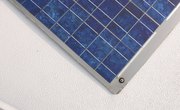
Photovoltaic solar cells absorb energy from sunlight and convert it into electrical energy. For the process to work, sunlight needs to make it into the solar cell material and get absorbed, and the energy needs to get out of the solar cell. Each of those factors influences the efficiency of a solar cell. Some factors are the same for large and small solar cells, but there are some that vary with size. The factors that vary tend to make it easier for smaller solar cells to be more efficient than their larger counterparts.
Efficiency
There are several different ways of defining efficiency. The one that makes the most sense from a consumer's perspective is as the ratio of electrical energy produced to total sunlight energy striking the area of the solar cell. There are many types of solar cells. Multifunction cells are very expensive, but can be in the neighborhood of 40 percent efficient. Silicon cells are 13 to 18 percent efficient, while other approaches called "thin film" cells are anywhere from 6 to 14 percent efficient. The material, the design and the construction of the cell have much more influence on efficiency than the size does.
Getting Light In
The first factor that determines the efficiency of a solar cell is the amount of light that makes it into the solar cell material. The surface of a solar cell needs to have some kind of electrical contact to complete the circuit and get the power out. Those electrodes block sunlight from reaching the absorbing material. Unfortunately, you can't just put small electrodes on the edge of a solar cell because then you lose too much of the electricity to resistance in the solar cell material. That means that if you have a large solar cell -- say about 5 inches square -- you will need to have several electrodes across the surface, blocking light. If your solar cell is half an inch by one inch then you can get by with a smaller percentage of the surface covered by electrodes.
Light In, Electrons Out
When sunlight gets into the solar cell material, it will travel along until it interacts with an electron in the material. If the electron absorbs the energy of the sunlight, it will be given a boost. It can lose that energy by bumping into other electrons. Mostly, that doesn't depend on the size of the solar cell. It just depends on its composition and design. However, if the electrons need to go further in the semiconductor material, it's more likely they can lose energy. By making the distance to the electrodes small, then it's less likely the electron will lose energy. Because larger cells are designed with more electrodes, the distance ends up being about the same, so this doesn't change too much with solar cell size.
Solar Cell Size
Resistance is a measure of how hard it is for an electron to travel through a circuit. With everything else being equal, shorter distance creates lower resistance, so that means smaller cells will waste less energy and be a little more efficient. Even though all those effects favor smaller cells over larger ones, they are very small influences on efficiency. Since solar cells only become really useful when they're combined together, it usually makes sense to use larger cells so you don't have to do as much assembly work. Typically, silicon solar cells are about 5 or 6 inches square to match the size of the raw silicon they're built from. They're then put together in panels a few feet on a side.
References
About the Author
First published in 1998, Richard Gaughan has contributed to publications such as "Photonics Spectra," "The Scientist" and other magazines. He is the author of "Accidental Genius: The World's Greatest By-Chance Discoveries." Gaughan holds a Bachelor of Science in physics from the University of Chicago.
Photo Credits
Sean Gallup/Getty Images News/Getty Images
